Real Wood Veneer and Inlaid Chess Boards
Now that I’ve looked at both traditional chess pieces and unique boards, I wanted to review the more classic and traditional chessboards available, specifically focusing on wooden boards such as walnut, teak, macassar, wengue, and mahogany chess boards.
While some chess sets will have a board included, when you’re looking at the nicer, hand carved pieces you’re more likely going to have to choose the right board on your own. That’s where this article comes in. I’ve already posted a little bit about sizing, so this time i’m going to discuss the options and styles available when you already know the right size.
First, I will look at the traditional flat chess boards available in a number of woods both traditional and exotic. These designs are high quality veneers that will compliment your luxury chess pieces very well. Second, we’ll take a look at inlaid boards. These elegant boards are another fantastic compliment to your luxury chess pieces, but have a few drawbacks. Finally, i’ll look at some of the storage options available for traditional chess pieces.

From rich Mahogany chess boards to luxury Wengue, Walnut, Padouk and more. We have a huge selection of chessboards. Click on the picture above to see them all!
Teak, Macassar, Walnut, and Mahogany Chess Boards… and more!
The most popular type of chess boards are veneer. Some people consider this a negative, but these boards are often the most rugged and resistant to weather fluctuations and cracking. I’ll discuss that a little more when I review inlaid boards. The reality is, real-wood veneer boards have been a mainstay for chess. There is no need to get a low quality board from China or Taiwan – in fact many of the most rich and elegant veneer chess boards are imported from Spain, where they have been made for decades.
There are a great number of veneer chess boards in a number of woods that will compliment any chess set. However, we’ll often find customers looking to match their pieces exactly, and there are not all that many ebony or rosewood chess boards around. The reason is that you generally want a nice contrast between your chess pieces and board. If the woods match exactly, the pieces can easily be lost in a game (which can be quite frustrating!) but also by matching they will not stand out to show how fantastic your pieces look.
That being said, Certain chess board woods go very well with certain chess pieces woods:
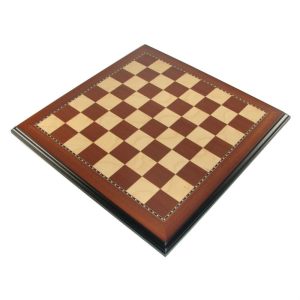
This is a Presidential Series Mahogany Chess Board. Mahogany is a light reddish color wood that displays a beautiful reddish sheen when polished. It is very popular in furniture and works well with a chess sets. The rich color of the wood works best with Rosewood, Crimson Rosewood, and Ebony chessmen.
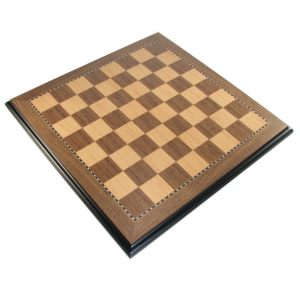
This is a Presidential Style Walnut Board. Walnut is a medium brown hardwood wood long considered a staple for chess boards. Seen here is European walnut, which is not as dark as American walnut. Perhaps the most popular wood, walnut can go with virtually any wood quite well. I feel the richness of the wood works particularly well with rosewood, honey rosewood, sheesham, and ebonywood chess pieces.
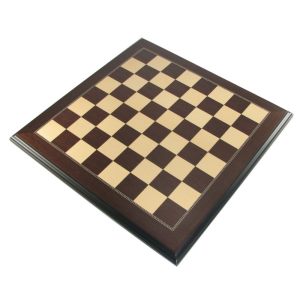
This is a Presidential Series Wengue Board. Wengue is the closest wood to Ebony, so if you are looking for a very dark natural wood tone this is a great choice. The wood is still more of a charcoal gray than black, but it works very well with ebony and ebonized chessmen. The reddish color of crimson rosewood also has a very rich appearance on a wengue board.
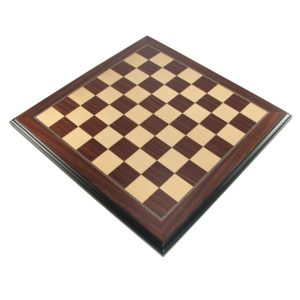
This is a Presidential Series Macassar Chess Board. Macassar is one of the more exotic woods found in chessboards, with a reddish milk-chocolate brown color with great variation and an excellent finish. Macassar is notable for the strong, narrow rows of differing color for a truly luxurious appearance. It is best suited with crimson rosewood, rosewood, and ebonywood chess pieces.
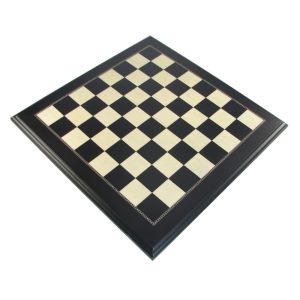
This is a Presidential Series Ebonized Maple Chess Board. If you are looking for a pure black board, Ebonized Birds Eye Maple is for you. The dark squares are lacquered black with a matte finish, which has no grain whatsoever. Birds Eye Maple has more knots and curls than traditional maple, and can be seen through the creamy white erable on the presidential version of the board. This board complements all types of woods, although particularly well with ebonized or ebonywood.
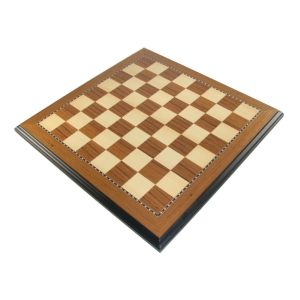
This image shows a Presidential Series Teak Chess Board. Teak is a light colored wood with a beautiful slight grain pattern. It is a lighter color than walnut and works particularly well with honey rosewood and sheeshamwood, but also looks well with ebony and ebonized men which give a very rich contrast between the board and pieces.

From Padouk butcher blocks to imperial Wengue inlays, there are many to choose from. Click here to see our complete collection
Inlaid Chess Boards
Another style of luxury chess boards that are well suited for many square sizes would be inlaid boards. The wood is thicker than a veneer, often with small blocks of woods on top of a base wood. These boards are sometimes lacquered for an extra rich look, and are usually a little more expensive than the veneer options.
These come in a number of woods that will often match the pieces exactly, offering you the chance to have a completely matching set if that is your desire. Frankly, we recommend against it but because they are different wood species, it often still will provide some contrast.
The most popular woods for an inlaid board are Walnut, Wengue, and Padouk. The Wengue in inlaid boards is a different species from the veneer, and is a darker and more brown version. Padouk is a reddish color that looks amazing with crimson rosewood or traditional rosewood chess pieces. The woods for inlaid boards are commonly different than those available for veneers, and you will not often find Teak, Macassar, or Mahogany chess boards in an inlaid form at an affordable price.
The one drawback of inlaid boards is that in some climates you mind find that they split over time. This is due to the different densities of the woods. If the humidity causes expansion, the softer wood has no where to go and causes the denser wood to split. As they look great out of the box, no one likes to see this happen to their board.
What about Storage Boards?
I’ve discussed storage boards in a previous post, but these are not a commonly used board style for nicer chess pieces. You don’t want to hide your pieces, you want to leave them out on display. When storage is needed, a great chess box (similar to a cigar humidor) is a really rich option that looks fantastic.
The storage boards that are available are almost universally from China and Taiwan and are acquired through distributors. This does not mean anything is wrong with them, but they are not made by the same companies that have specialized in high quality wooden chessboards for years and years – so the wood quality might be different, and they are less likely to have exotic wood choices.
Finally, Storage can be a very fickle thing. most of those boards are intended for theme style pieces. There is a lot of internal variation from one chess set to another, so the storage option might not fit the pieces you’re chosen even when the overall playing surface and square size will.
As always, if you have any questions or comments, please feel free to send me an email or put a comment down below.
Quentin Turner

hello i have to tell you about the excellent website which I recently found. It is an excellent site about gaming with a huge quantity of games and many other features. See yourself!